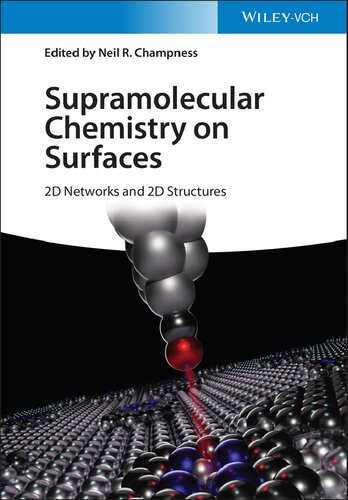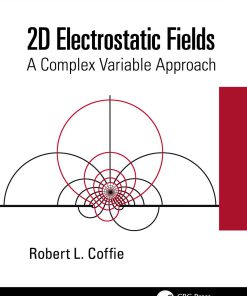Supramolecular Chemistry on Surfaces 2D Networks and 2D Structures 1st Edition by Neil Champness 3527344918 9783527344918
$50.00 Original price was: $50.00.$25.00Current price is: $25.00.
Supramolecular Chemistry on Surfaces 2D Networks and 2D Structures 1st Edition by Neil Champness – Ebook PDF Instant Download/Delivery: 3527344918, 9783527344918
Full download Supramolecular Chemistry on Surfaces 2D Networks and 2D Structures 1st Edition after payment

Product details:
ISBN 10: 3527344918
ISBN 13: 9783527344918
Author: Neil R. Champness
In Supramolecular Chemistry on Surfaces: 2D Networks and 2D Structures, expert chemist Neil R. Champness delivers a comprehensive overview of the rapidly developing field of two-dimensional supramolecular chemistry on surfaces. The book offers explorations of the state-of-the-art in the discipline and demonstrates the potential of the latest advances and the challenges faced by researchers in different areas.
The editor includes contributions from leading researchers that address new spectroscopic methods which allow for investigations at a sub-molecular level, opening up new areas of understanding in the field. Included resources also discuss important supramolecular strategies, like hydrogen-bonding, van der Waals interactions, metal-ligand coordination, multicomponent assembly, and more. The book also provides:
- A thorough introduction to two-dimensional supramolecular chemistry on surfaces
- Comprehensive explorations of the characterization and interpretation of on-surface chemical reactions studied by ultra-high resolution scanning probe microscopy
- Practical discussions of complexity in two-dimensional multicomponent assembly, including explorations of coordination bonds and quasicrystalline structures
- In-depth examinations of covalently bonded organic structures via on-surface synthesis
Perfect for polymer chemists, spectroscopists, and materials scientists, Supramolecular Chemistry on Surfaces: 2D Networks and 2D Structures will also earn a place in the libraries of physical and surface chemists, as well as surface physicists.
Supramolecular Chemistry on Surfaces 2D Networks and 2D Structures 1st Table of contents:
1 Two-Dimensional Supramolecular Chemistry on Surfaces
Neil R. Champness
References
2 Characterisation and Interpretation of On-Surface Chemical Reactions Studied by Ultra-High-Resolution Scanning Probe Microscopy
Adam Sweetman, Neil R. Champness, and Alex Saywell
2.1 Introduction
2.2 SPM Under UHV Conditions
2.2.1 On-Surface Reactions
2.2.2 Characterisation of Molecule-Substrate Systems via STM
2.2.3 ncAFM
2.3 Practical Steps in Accomplishing Sub-Molecular Imaging
2.3.1 Sample Preparation
2.3.1.1 Deposition of Organic Molecules at Low Temperature
2.3.1.2 CO Deposition
2.3.1.3 Decoupling Layers
2.3.2 Construction of the qPlus Sensor
2.3.3 Tip Preparation
2.3.3.1 Tip Functionalisation
2.3.4 Practical Considerations for Imaging
2.3.4.1 Drift and Creep
2.3.4.2 Amplitude Calibration
2.3.4.3 Apparent Dissipation and Mechanical Coupling of the Sensor
2.3.4.4 Crosstalk
2.3.4.5 Force Inversion
2.4 Interpretation of Sub-Molecular Contrast at the Single Bond Level
2.4.1 Forces in the Tip-Sample Junction 24
2.4.1.1 Non-site Specific Interactions – The ‘Background’
2.4.1.2 Local Dispersion Interactions – The ‘Halo’
2.4.1.3 Pauli Repulsion – The ‘Carbon Backbone’
2.4.1.4 Chemical Bonding
2.4.1.5 Local Electrostatic Interactions
2.4.2 Response of the Probe Particle – Distortions in Imaging
2.4.2.1 Flexibility of Adsorbed CO
2.4.2.2 Electrostatics
2.4.2.3 Chemical Sensitivity
2.5 Characterising On-Surface Reactions with ncAFM
2.5.1 Practical Considerations for Characterising On-Surface Reactions
2.5.2 Synthesis and Characterisation of Graphene Based Nanostructures
2.5.3 Studying the Evolution of On-Surface Reaction
2.6 Conclusions
Acknowledgements
References
3 Complexity in Two-Dimensional Multicomponent Assembly
Kunal S. Mali, Joan Teyssandier, Nerea Bilbao, and Steven De Feyter
3.1 Introduction
3.2 Two-Component Self-Assembled Systems
3.2.1 Two-Component Systems: Host–Guest Architectures
3.2.1.1 Host Networks from Intrinsically Porous Building Blocks
3.2.1.2 Host Networks from Self-Assembly of Building Blocks
3.2.1.3 Two-Component Systems: Host–Guest ArchitecturesBased on Surface-Confined Two-Dimensional Covalent Organic Frameworks (2D-sCOFs)
3.2.2 Two-Component Systems: Non-Host–Guest Architectures
3.3 Three-Component Systems
3.3.1 Three-Component Systems: Two-Component Host Network + Guest
3.3.2 Three-Component Systems: One-Component Host Network + Two Different Guests
3.3.3 Three-Component Systems: Non-host–Guest Systems
3.4 Four-Component Systems
3.4.1 Four-Component Systems: Host–Guest Architectures
3.4.2 Four-Component Systems: Non-host–Guest Architectures
3.5 Summary and Perspectives
References
4 Complexity in Two-Dimensional Assembly: Using Coordination Bonds
Nian Lin and Jing Liu
4.1 Introduction
4.2 Asymmetric Linkers
4.3 Multiple Types of Linkers
4.4 Multiple-Level (Hierarchical) Interaction
4.5 Multiple Binding Modes
4.6 Summary and Outlook
References
5 Complexity in Two-Dimensional Assembly: Quasicrystalline Structures
S. Alex Kandel
History 103
Random Tilings
Quasicrystalline Tilings
References
6 Using Self-Assembly to Control On-Surface Reactions
Zhantao Peng, Lingbo Xing, and Kai Wu
6.1 Introduction
6.2 Mediating On-Surface Reaction Selectivity
6.3 Mediating On-Surface Reaction Pathway
6.4 Mediating On-Surface Reaction Site
6.5 Brief Summary and Perspective
Acknowledgement
References
7 Covalently Bonded Organic Structures via On-Surface Synthesis
Can Wang, Haiming Zhang, and Lifeng Chi
7.1 Introduction
7.2 Dehalogenation
7.2.1 Ullmann Coupling
7.2.2 Sonogashira Coupling
7.2.3 Heck Reaction
7.3 Dehydrogenation
7.3.1 (SP 3 -C) Alkane Polymerisation
7.3.2 (SP 2 -C) Aryl and Alkene Cyclodehydrogenation
7.3.2.1 Aryl–Aryl Dehydrogenation Coupling
7.3.2.2 Bottom-Up Fabrication of Graphene Nanoribbons (GNRs)
7.3.2.3 Homo-Coupling of Terminal Alkene
7.3.3 (SP 1 -C) Alkyne – Glaser Coupling
7.3.4 Hierarchical Dehydrogenation of X—H Bonds (X = N and C)
7.4 Dehydration Reaction
7.4.1 Schiff-Base Reaction
7.4.2 Imidisation Condensation Reaction
7.4.3 Boronic Acid Conden
7.4.4 Decarboxylative Polymerisation
7.4.5 Dimerisation and Cyclotrimerisation of Acetyls
7.5 Other Reactions
7.5.1 Click Reaction
7.5.1.1 Azide–Alkyne Cycloaddition
7.5.1.2 Diels–Alder Reaction
7.5.2 Bergman-Like Reaction
7.5.3 N-Heterocyclic Carbenes Formation and Dimerisation
7.5.4 σ-Bond Metathesis
7.5.5 Diacetylene Polymerisation
7.6 Conclusion and Perspectives
References
8 Hybrid Organic-2D TMD Heterointerfaces: Towards Devices Using 2D Materials
Yu L. Huang and Andrew T. S. Wee
8.1 Introduction
8.2 Atomic Structures
8.2.1 Pristine 2D TMDs
8.2.2 Organic/2D TMD Interfaces
8.3 Surface Functionalisation of 2D TMDs by Organics
8.3.1 Defect Engineering
8.3.2 Phase Engineering
8.4 Fundamental Electronic Properties
8.4.1 Energy Level Alignment
8.4.2 Interfacial Charge Transfer
8.4.3 Screening Effect
8.5 Applications in Devices: Organic-2D TMD p–n Heterojunctions
8.6 Conclusion
Acknowledgements
References
9 Surface Self-Assembly of Hydrogen-Bonded Frameworks
Nicholas Pearce and Neil R. Champness
9.1 Introduction
9.2 Carboxylic Acid Supramolecular Synthons
9.3 Imide-Melamine Supramolecular Synthons
9.4 From Hydrogen-bonding Synthons to Covalently-organic Frameworks
9.5 Heteromolecular Hydrogen-bonding Synthons
9.6 Conclusions
People also search for Supramolecular Chemistry on Surfaces 2D Networks and 2D Structures 1st:
supramolecular chemistry applications
3 molecules of sucrose
surface chemistry examples
what is supramolecular chemistry
Tags:
Neil Champness,Supramolecular,Chemistry,Surfaces
You may also like…
Chemistry - Chemistry - General & Miscellaneous
Computers - Programming
Uncategorized
Computers - Computer Graphics & Design
Chemistry - Inorganic Chemistry
Photocatalysis Using 2D Nanomaterials 1st Edition Yufei Zhao
Computers - Programming
Hands on Rust Effective Learning through 2D Game Development and Play 1st Edition Herbert Wolverson
Computers - Artificial Intelligence (AI)
Machine Learning in 2D Materials Science 1st Edition Parvathi Chundi
Computers - Operating Systems










